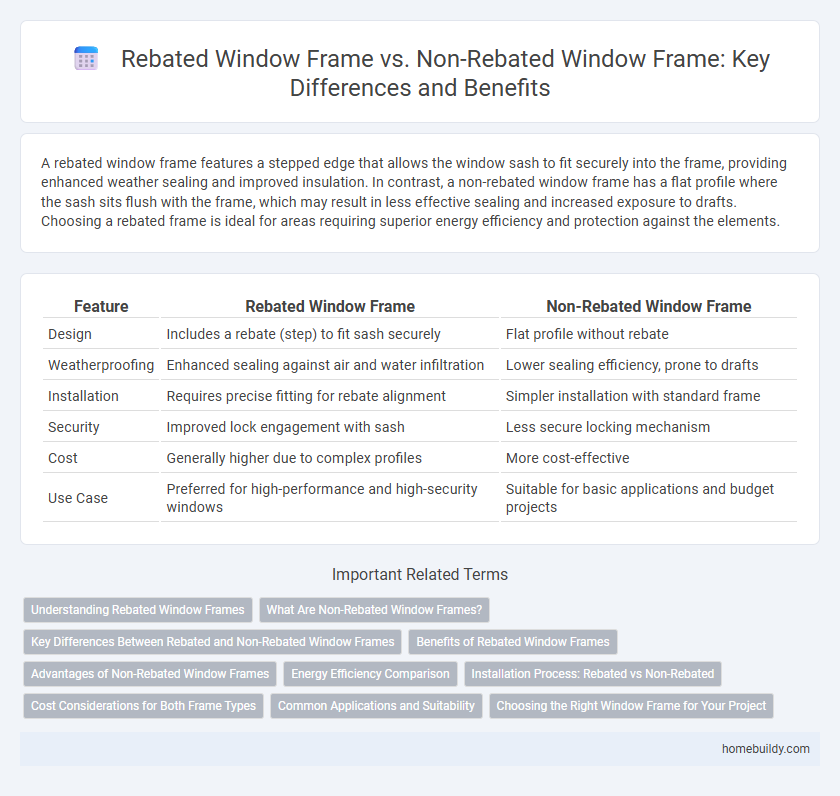A rebated window frame features a stepped edge that allows the window sash to fit securely into the frame, providing enhanced weather sealing and improved insulation. In contrast, a non-rebated window frame has a flat profile where the sash sits flush with the frame, which may result in less effective sealing and increased exposure to drafts. Choosing a rebated frame is ideal for areas requiring superior energy efficiency and protection against the elements.
Table of Comparison
| Feature | Rebated Window Frame | Non-Rebated Window Frame |
|---|---|---|
| Design | Includes a rebate (step) to fit sash securely | Flat profile without rebate |
| Weatherproofing | Enhanced sealing against air and water infiltration | Lower sealing efficiency, prone to drafts |
| Installation | Requires precise fitting for rebate alignment | Simpler installation with standard frame |
| Security | Improved lock engagement with sash | Less secure locking mechanism |
| Cost | Generally higher due to complex profiles | More cost-effective |
| Use Case | Preferred for high-performance and high-security windows | Suitable for basic applications and budget projects |
Understanding Rebated Window Frames
Rebated window frames feature a stepped edge or groove that allows the window sash to fit securely within the frame, enhancing weatherproofing and improving thermal insulation. These frames provide superior airtightness and increased resistance to water infiltration compared to non-rebated frames, which lack this interlocking profile and rely more on seals alone. Understanding the benefits of rebated window frames is crucial for selecting windows that optimize energy efficiency and durability in construction.
What Are Non-Rebated Window Frames?
Non-rebated window frames feature a flush design where the sash and frame sit on the same plane, allowing for smoother operation and a streamlined appearance. These frames are typically lighter and easier to install compared to rebated frames, making them suitable for modern architectural styles. Non-rebated frames provide adequate weather sealing but may offer less resistance to water infiltration than rebated window frames.
Key Differences Between Rebated and Non-Rebated Window Frames
Rebated window frames feature a stepped edge that provides enhanced sealing and improved weather resistance by overlapping the sash and frame, reducing air and water infiltration. Non-rebated window frames have flush edges, resulting in a simpler design but less effective insulation and security compared to rebated frames. The choice impacts thermal efficiency, water-tightness, and installation complexity, making rebated frames preferable for high-performance applications.
Benefits of Rebated Window Frames
Rebated window frames offer superior weather resistance by creating a tighter seal that prevents water and air infiltration, enhancing energy efficiency in buildings. Their design improves sound insulation, reducing noise pollution and increasing indoor comfort. The structural integrity of rebated frames provides better security and durability compared to non-rebated alternatives.
Advantages of Non-Rebated Window Frames
Non-rebated window frames offer smoother installation and improved sealing due to their single-plane design, which minimizes gaps and potential air leakage. They provide a sleek, modern aesthetic ideal for contemporary architecture and require fewer materials, reducing overall costs. Enhanced ease of maintenance and cleaning is another key advantage, as their simpler structure eliminates crevices where dirt and moisture can accumulate.
Energy Efficiency Comparison
Rebated window frames create a tighter seal by overlapping the sash and frame, significantly reducing air leakage and improving thermal insulation, which enhances overall energy efficiency. Non-rebated window frames lack this overlapping design, often resulting in higher drafts and heat loss, leading to lower energy performance. Studies show rebated frames can reduce heating and cooling costs by up to 15% compared to non-rebated options due to superior airtightness and insulation properties.
Installation Process: Rebated vs Non-Rebated
Rebated window frames require precise alignment during installation to ensure the overlapping rebate seals effectively against weather elements, enhancing insulation and security. Non-rebated window frames offer a simpler installation process, as they fit directly into the frame without the need for overlapping sections, reducing labor time and skill requirements. Proper installation of either type involves ensuring a tight fit to prevent air leaks and water ingress, with rebated frames typically demanding more meticulous sealing techniques.
Cost Considerations for Both Frame Types
Rebated window frames typically incur higher costs due to additional materials and labor required for the stepped profile that improves sealing and security. Non-rebated window frames, being simpler in design, offer a more budget-friendly option with faster installation times but may compromise on weatherproofing and durability. Choosing between the two depends on balancing upfront expenses with long-term maintenance and energy efficiency benefits.
Common Applications and Suitability
Rebated window frames are commonly used in residential buildings and historical restorations where weatherproofing and enhanced security are priorities, as their stepped design provides better sealing against water and air infiltration. Non-rebated window frames suit commercial and modern architectural applications where a sleek, minimalist appearance is desired, offering easier installation but less resistance to drafts and water ingress. Choosing between rebated and non-rebated frames depends on environmental exposure, security needs, and aesthetic preferences specific to each project.
Choosing the Right Window Frame for Your Project
Rebated window frames feature interlocking profiles that create a tighter seal, enhancing thermal insulation and soundproofing, making them ideal for energy-efficient buildings and noise-sensitive environments. Non-rebated window frames, with their simpler, flush design, offer easier installation and cost-effectiveness, suitable for projects prioritizing budget and quick assembly. Selecting between rebated and non-rebated frames depends on project requirements such as climate control, budget constraints, and aesthetic preferences.
rebated window frame vs non-rebated window frame Infographic

 homebuildy.com
homebuildy.com